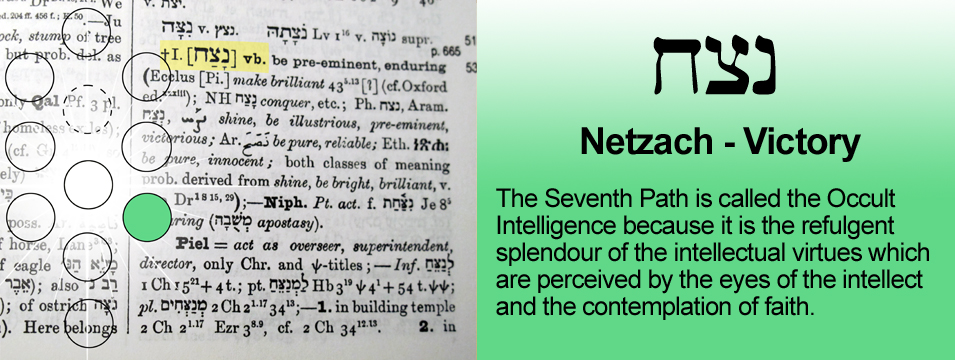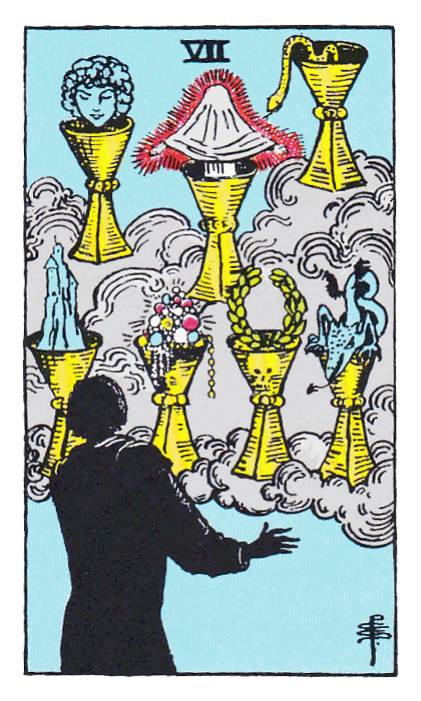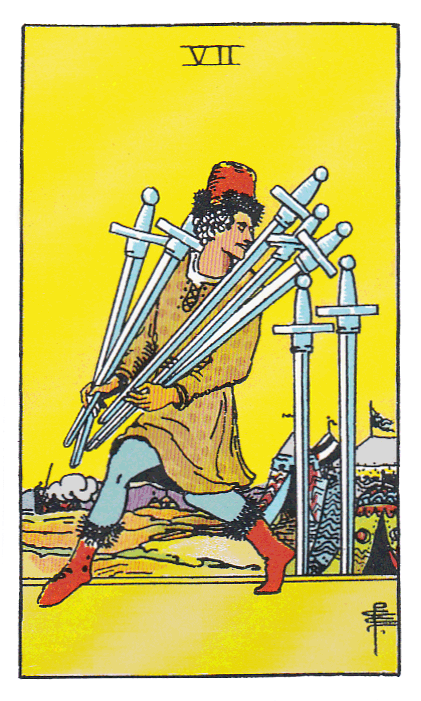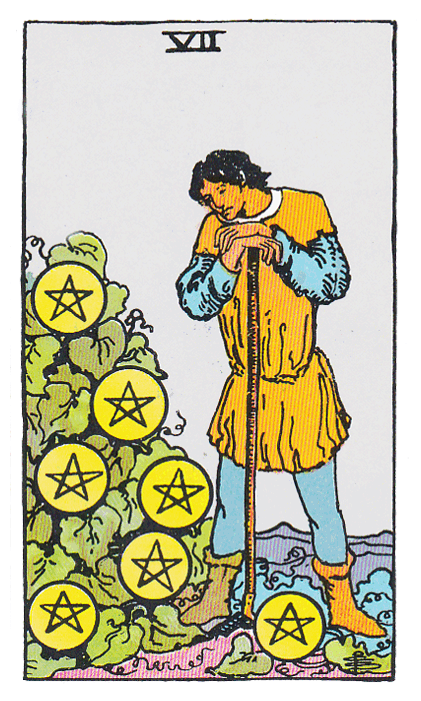|
======================================================================
Description:
The following papers describe Netzach, the Seventh Sephirah (More to follow)...
(Updated 14 November 2020)
======================================================================
Netzach
By Brenda Budgen (1988)
I shall deal with two aspects:
1) In life things are either abstract or concrete, for example (abstract) honesty, love, hate, and (concrete) table, pen, cup. You do not find an honest pen, nor a hateful table. Yet Netzach partakes of both qualities. This is shown by the Yetziratic text: "the splendour of the intellectual virtues perceived by the eyes of the intellect and the contemplations of faith". All these latter are abstract ideas, yet the symbols of Netzach are very concrete - the lamp, girdle and rose. Netzach represents instincts and emotions - again, abstractions which are difficult to understand.
We see this dual quality again in considering our human consciousness, for in Netzach we break free from crystallised thought which prevents change and work in the plane where reforms and freedom of thought take place. It is apparent too, as we move down the four worlds. In Atziluth imagination is archetypal, in Briah we have abstract ideas, in Yetzirah concrete ideas, and in Assiah these ideas are solidified - all in Netzach.
2) This brings me to the second aspect of Netzach - a brief study of Venus.
Venus too shows us this conjoining of abstraction and concrete in the sign of the planet, the circle of the spirit being above, therefore having precedence over the cross of matter. The cross is emblematic of an harmonious union of two male elements: fire and air, with the two female elements, earth and water. This is yet another example of the polarity which is such an important feature of Netzach, and indeed of the whole Tree. To the occultist, the desire of the sexes to merge together as one is illustrative of the natural urge in humanity (the cross) to return to the circle of completeness, and thus achieve harmony. Venus is the giver of life's gifts and pleasures, for she is the personification of beauty and increment. It is her task to inspire human beings with the desire for material and spiritual growth. She is a goddess of protection, the representative of our capacity for achieving harmony.
When we have the capacity to respond on all planes to the call of Venus, but can easily and without effort refrain from responding, we are initiates of Netzach - Love under Will.
======================================================================
Netzach
By Patricia Fox (1987)
Netzach’s position is at the foot of the Positive Pillar and is the last Sephirah on this pillar. Its polarity upon the Tree makes it negative to Gedulah and Tiphareth but positive to Yesod and Malkuth.
This seventh path is the Occult Intelligence, the refulgent splendour of all occult virtues. That is, intelligence beyond the range of ordinary knowledge seen by the eyes of the enlightened - shining and gloriously bright.
From Gedulah the fourth Sephirah, the inspiration flows down into Netzach and becomes imagination.
In the world of Atziluth the creative faculty of the mind is only the inherited image. The world of Briah produces from these abstract forces, abstract form and in the formative world of Yetzirah the imagination produces real ideas. The World of Assiah is where these ideas are solidified.
The mundane chakra is Venus and Netzach represents the instincts and the emotions they give rise to. In Netzach, force is still relatively free-moving, being bound only into ever-shifting shapes. A particular form of force represents itself as a type of being, flowing backwards and forwards over the boundaries of manifestation. Such, beings have no individualised personalities as all mind is group-mind in Netzach.
Exaggeration can take place in this sphere especially at the Yetzirah and Assiah levels, because the appearances of forms as represented by the intellect is projected back into the astral light as thought forms. We find here by means of intuition, that our apprehensions have been formless or at the very least highly abstract symbols.
The Refulgent Splendour of the many-rayed hues in Netzach is the white light as seen through a prism. Here we have forces not force, lives not life.
The Host of Angels are the Elohim (Gods). The Elohim are not so much intelligences as the embodiments of ideas. They are the formative influences whereby the creative force expresses itself in Nature. The One has been reduced to Many for the purpose of manifestation in form.
Every life or form of force manifesting here is a partial but specialised manifestation. It is the Netzach factor within ourself that is the basis of our instincts.
An important point to remember when working with the lower Sephiroth is that of illusion. Densely populated by thought forms, however dimly, a form builds about itself out of the astral light. The more the human imagination has dwelt upon it, the more definite the form becomes. We can be deceived into mistaking them for abstract essence itself which is not to be found upon any plane that yields images to psychic vision, but only upon those that are discerned by pure intuition.
It is by means of dance, sound and colour that the angels in Netzach are contacted and evoked. We enter communion with the object of our adoration by means of the arts. All rites that have rhythm, movement and colour work in this Sephirah. Netzach is the emotional side of our nature and the artist within us.
Venus (in Greek mythology, Aphrodite) is the goddess of love. In this sphere on the lower vibrations it is sexual love rather than spiritual love.
Netzach means Victory and an additional title is Firmness which carries out the same idea of masterful and victorious energy. The Divine name is Jehovah Tzabaoth, meaning the Lord of Hosts. We must understand the righteousness of beauty as well, as the beauty of righteousness, if we want to bring all the levels of the inner kingdom into obedience to the central power of unified consciousness. At this point the inner aspect of the personality emerges as yet not touched.
Initiation develops the powers of the higher psychism which helps us to understand spiritual truths. To help in our human development we need to develop our power to contact natural energy, which, in its essential form, is in Netzach. It is here that we learn the ability to merge into the one life.
Netzach is animportant sphere from the point of view of the practical work of occultism, we have to initiate sub-consciousness as well as consciousness, and illuminate the instincts as well as the reason.
The magical image of this sphere is a beautiful naked woman, and the spiritual experience assigned here is the Vision of Beauty Triumphant, all in keeping with the planet Venus. The virtue is unselfishness, the capacity to restrict vibrations from the negative pole. The vices are those of love abused, unchastity and lust.
In the Divine Man, Netzach relates to the right hip, loins and right leg. This area forms part of the setting for the generative organs but not the actual organs themselves.
The magical weapons are the lamp and the girdle. The girdle is associated traditionally with Venus, and also a cord or belt worn around the waist or hips. The lamp is a magical weapon used in operations of the element of fire. Fire is associated with Netzach and the fiery energy at the heart of Nature.
The four Tarot cards assigned to Netzach are the sevens and reveal the nature of the Venusian influence as it comes down the planes. They teach a very important lesson for they show how unstable this force is unless it is rooted in spiritual principle. The lower forms of love are the emotions and essentially unreliable; but the higher love is dynamic and energising.
Seven of wands Valour
Seven of cups Illusory success
Seven of swords Unstable effort
Seven of pentacles Success unfulfilled
The seventh degree of Gold, Zahab Sagur is referred to Netzach - this is fine treasured gold, shut up and prevented outlet.
In the Netzach state of consciousness the masculine finds the feminine within itself. This is best explained in the mythological symbolism of the Garden of Eden. Mankind making the choice 'to bite or not to bite’.
The chakra through which flows the Netzach force is Manipuri, the solar plexus, and the Archangel of this sphere is Haniel.
In Kabbalistic alchemy, tin is associated to Netzach, this is a metallic element nearly like silver in its whiteness.
The Gods of Netzach are:
Nike - Greek goddess of victory. Frequently identified with Athene.
Hathor - Egyptian goddess of love.
Aphrodite - Greek goddess of love, beauty, and fertility; born of the sea-foam. Identified by the Romans with Venus.
The animals connected to this sphere are the lynx which is a member of the cat family with tufted ear-tips and short tail; the dove, which is symbolically the bird of peace and innocence, and the cat, a member of the genus felis, from which the domesticated cat is evolved.
The perfumes of Netzach are:
Benzoin - Fragrant aromatic resin obtained from various trees of the genus Styrax from Sumatra and Thailand.
Red Sandal - An odorous dye-wood.
Rose - A beautiful fragrant flower. The rose is also the symbolic flower of this sphere, with its beauty and association with love.
The green ray of harmony, balance and the colour of nature is portrayed in Netzach, the green ray brings a feeling of renewal, of new life and brightness. The qualities of the emerald improve the intellect and memory.
The colour scales of Netzach are:
Atziluth Amber
Briah Emerald
Yetzirah Bright yellowish green
Assiah Olive, flecked with gold
======================================================================
Netzach
By Ron Ransom (1994)
A description given to ‘Netzach’, whose magical image is that of a beautiful naked woman, is ‘Victory’. It is the seventh Sephirah and is situated at the foot of the ‘Pillar of Mercy’. In considering Netzach, one must also take ‘Hod’, into account. This latter mentioned Sephirah, the eighth, is to be found at the foot of the ’Pillar of Severity’, and is the balanced opposite of Netzach. The latter is termed ’Force’. Hod on the other hand is termed ‘Form’.
All of the writers whose work I have perused, acknowledge that Netzach is the sphere of Venus and Netzach, is where the Elemental sphere is entered, in which Nature’s Forces, in a manner of speaking, make themselves felt.
This Sephirah begins ‘the Astral Triangle’. It is the first of the Sephiroth wherein the “Personality”, composed of the four elements - Fire, Water, Air and Earth - each being represented by one of the lower Sephiroth - is made up. The Astral aspect is covered quite well in most volumes I have studied. I was however, very interested in the points made in Dion Fortune’s “Mystical Qabalah” about the Astral, insofar as the Sephirah Netzach is concerned.
Fire is the element attributed to Netzach. Importantly, insofar as human principles are concerned, is it’s representation of emotional life. Having already made the point of Netzach, being as it were, closely bound up with Hod, one cannot ignore the latters meaning i.e. “Splendour”. When thinking of the word “Fire”, a relationship that sometimes springs to mind, is the word “Water”. It was therefore, not too much of a surprise to learn that the element of Hod is just that, Water.
Intellect is part of the personality associated with Hod, and this to my mind, is brought out very neatly in the ‘Golden Dawn’ which refers to the thinking, logical capacity in man, as well as his so-called magical or nervous force. Netzach then, provides the emotional drive. Hod however, furnishes the mental faculty which produces accurate assessment, plus the means of arriving at a logical solution or conclusion.
Taken from a universal standpoint (Macrocosm) there are, in the two Sephiroth in question, two levels of Force in to Form. In the first case i.e. in Netzach, Force is not static, it is free moving or fluid and always changing shape. As previously mentioned, Hod is defined as Form and it is here that for the first time Force takes on a definite - although somewhat flimsy - and lasting Form.
One of the hardest things to understand in life is, it seems to me, the mind. I can therefore, appreciate the contention of those writers who say Netzach is a particularly difficult Sephirah to fathom, in the sense that it must be approached from the standpoint of both Macrocosm and Microcosm. A key, I think lies in the view propounded in the “Qabalistic Tarot” that all mind is “Grouped Mind” in Netzach i.e. it is a part of that group which, as it becomes Self - Understanding, also understands the whole.
A good example of this factor is illustrated by the author of the aforementioned volume, who says, “An artist uses Netzach qualities to draw forth creative images from it. As the Artist increasingly develops his ability to create and understand the nature of his own creative act, he also develops an understanding of the nature of the Arts in general. In the course of developing his creativity in this way, and to provide a serious work, the artists feelings must, however, be tempered by the discipline of Hod (Reason). The same rule applies to the scientist, who functions through Hod, the Sephirah where the general becomes specific.” (Other writers e.g. Dion Fortune, also comment on these aspect). One can therefore, see the balance of these Sephiroth being (a) Feelings and Instincts in Netzach, and (b) Intellect in Hod.
It has also been stated that Netzach is the sphere where the Forces of Nature hold sway. One of the important aspects here is, of course, Love. It seems logical therefore that this is also the sphere of “Venus - Aphrodite” the Goddess of Love. One of the higher qualities of Love, is I feel, that of being unselfish. Having said that, it is worth bearing in mind the vices pointed out in “Kabbalistic Aphorisms, i.e. Avarice and Lust.
There are three key symbols associated with Netzach, i.e. The Lamp, The Girdle and The Rose. Most people, I think, regard the Rose as a token of Love - truly a Venus attribute - and without doubt it is a flower prized by gardeners’ wherever it is grown throughout the world.
The Girdle too, is a Venus attribute. To learn the secret of the “Knot” in her Girdle, means says Robert Wang, to direct the Venus Forces of Nature, to tie them up or release them at will.
Finally, there is the symbol of the Lamp which is I feel, an ideal choice as the magical weapon used in operations connected with Fire. Here there is a clear Netzach connection. The Element of Fire is also associated with the fiery energy at the centre of Nature, and thus with the belligerent powers of mars. A study of the symbolism, Dion Fortune points out, portrays that the Mars or Victory symbolism is associated with the Macrocosm, and the Venus or Love symbolism, with the Microcosm. It is, she says, best explained by saying that Elemental energy, or the fundamental dynamism of an individual, is very closely connected with the sex life of the individual.
======================================================================
The Psychological Aspects of Netzach
By Richard F. Stewart (1986)
If the psychological aspects of Netzach represent something, it must surely be the archetype of maturity. For here the individuation process reveals the blossoming of the age betwixt youth and old age. It is the time following the turmoil of puberty and the striving for stability through the anima and the animus.
The power of Netzach in the psychology of humanity represents the instinctual side of nature which complements the intellectual and analytical aspect of mind.
The image of Netzach is a beautiful naked woman, the symbol of the anima. Appealing to the masculine gender this image represents the ideal of harmony and fruition. It is this symbol which, in various forms, appear to the male to beckon him towards harmonising his consciousness with that of the unconscious. If the anima is accepted, then he realises the potential of his imagination and instinctual life and can more readily integrate this within himself. The appreciation of instinctual life gives rise to interest in the creative arts such as music, art, movement and beauty in form. All these various aspects are projections by the anima within as signposts of her existence.
By realising the way in which the naked woman affects us we may derive understanding and inspiration from the associations. The anima image can equally be warped whereby the male becomes self indulgent and devoted to a life of comfort-seeking, sexuality and lust. The naked woman generally has an expansive outgoing stimulus which she lends to those who can grasp her identity. She provides a richness to man's life which is invaluable to his conscious life and everything becomes fertile, and broadmindedness ensues.
With the reception of the naked woman into the life of the female, inspiration is given to turn inward or to pursuits outside of the normally accepted womanly realm, such as a monastic life or the teaching professions. Again the anima figure can dominate to the extent where introversion seems necessary to avoid the dangers of the exterior world.
In the Orphic and Delphic Mysteries we see the action of the naked woman upon the female as oracles of priestesses or seers, who mediate between the gods and man, bringing wise organisation and deliberations to individuals and societies. This, I think, is an acceptance of the anima into the feminine life, and the harmony which ensues when the conscious and unconscious images align and unify themselves.
======================================================================
Egyptian Gods to Netzach
By D.M. Dalton (1981)
Netzach carries the meanings of victory, triumph, splendour, and strength, so it seems logical that the gods and goddesses of the Hunt are attributed to this sphere. Netzach is also the sphere of Nature, and hence fertility and passion, the generative powers of nature.
The Greeks identified Hathor with their goddess Aphrodite. Hathor represented what was true and good, and all that was best in woman as wife, mother and daughter; she was the patron goddess of all singers, dancers; of beautiful women and of love, artists, and also the vine and wine and anything which contributed to joy and happiness. She was also connected with the rise of the Nile preparatory to the inundation.
Hathor, as lady of the Underworld, also played a prominent part in connection with the welfare of the dead, for without her help and protection the deceased could never attain everlasting life.
Hathor is another goddess like Isis, who gained the attributes of nearly all the other female deities. She represented the great mother of the world, and the old cosmic Hathor was the personification of the great power of Nature which was perpetually conceiving and creating, and rearing and maintaining all things. There is virtually no attribute which cannot be placed upon Hathor.
Sati was the principle female counterpart of Khnemu, "the Governor of the House of Life". Sati was a goddess of fertility, the life-giving waters of the Nile, and the scattering and sowing of seed. In earlier times she was a goddess of the chase. She is closely identified with Isis and Hathor. Sati's northern counterpart seems to be Neith, the goddess of the chase.
Sati had a sister goddess Anquet. As an aspect of Isis, Ankhet was the giver and producer of life. Her southern counterpart was Nepthys. Anquet means "to embrace", "to surround". She is designated as "the giver of life, and of all power, and of all health, and of all joy of heart". She was also a goddess of lust.
Male gods to this sphere are harder to find, but one candidate could be Osiris. He was a fertility god, had connections with the dead, also with the life-giving waters of the Nile.
The goddess Qetesh was regarded, along with Ashtharthet, as a form of Hathor, the goddess of love and beauty, as well as being a moon goddess. Qetesh was worshipped as a nature goddess, which was done in a licentious manner.
Another Syrian goddess, which the Egyptians adopted, was Ashtereth, adopted about the time of pharoah Thothmes III. She was identified with one of the forms of Hathor, Isis-Hathor. She was both a moon goddess and a destroying goddess of war.
Some of the forms of Isis applicable to this sphere are: as the goddess of harvests she was Henenet; as the goddess of cultivated fields and lands she was Sekhet; as the producer and giver of life she was Ankhet; as the embracer of the land and producer of fertility by her waters she was Anquet.
Possibly all of the pantheon of Egypt could be attributed to the sphere of Netzach, the Order of Angels being the Elohim, or gods.
======================================================================
To be continued...
|












